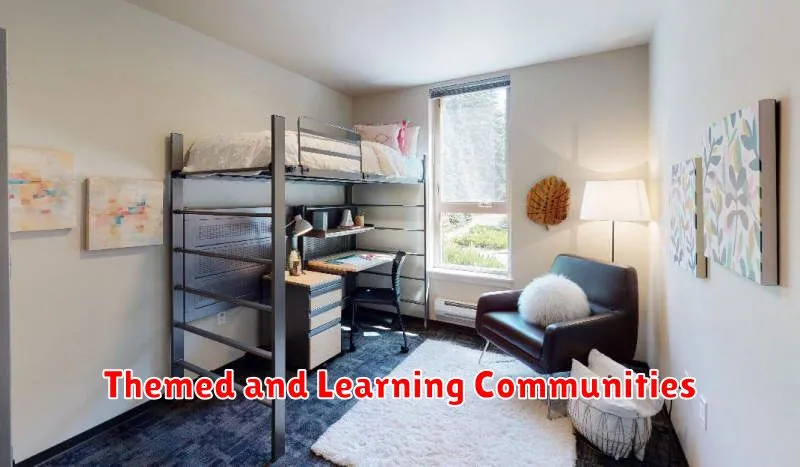Navigating the world of student housing can be a daunting task. This guide aims to provide a comprehensive overview of on-campus housing options, helping students make informed decisions about their living arrangements. We’ll cover key aspects of campus housing, from dormitories and residence halls to student apartments and suite-style living. Understanding the nuances of each option, including amenities, costs, and community dynamics, is crucial for a successful college experience. Whether you are a freshman, transfer student, or graduate student seeking on-campus accommodation, this guide offers valuable insights into finding the perfect fit.
Choosing the right student housing is an essential step in transitioning to college life. This guide will delve into the various on-campus housing options available, highlighting the pros and cons of each. We will explore important factors such as proximity to classes, meal plans, social opportunities, and the application process for campus housing. From traditional dormitories to modern student apartments, we’ll equip you with the knowledge necessary to choose the on-campus accommodation that best suits your needs and preferences. With this guide, you can embark on your academic journey with confidence, knowing you have secured comfortable and convenient student housing within the vibrant campus community.
Dormitories and Residence Halls
Dormitories and residence halls are typically the most common on-campus housing option. They offer a variety of room types, from single to multiple occupancy, and often include shared bathroom facilities. Residence halls are a great way to meet new people and become immersed in campus life.
These options usually provide furnished rooms and may include amenities such as laundry facilities, common areas, and meal plans. Living in a dormitory or residence hall offers convenience and close proximity to classes and campus resources.
Roommate matching processes vary, but often include questionnaires or surveys to help pair students with compatible lifestyles and preferences. Costs for dormitories and residence halls tend to be competitive with other off-campus options, particularly when factoring in the included amenities.
Apartment-Style Housing
Apartment-style housing offers students a more independent living experience. These units typically include a private or shared kitchen, bathroom, and living area, providing a home-like environment.
Occupancy can vary, with apartments designed for single students, small groups, or even larger families. Amenities often include on-site laundry facilities, parking, and sometimes additional features like fitness centers or study rooms.
Apartment-style housing is generally considered a premium option and may have a higher cost compared to other on-campus housing choices. It’s ideal for students who prefer more privacy, space, and the ability to cook their own meals.
Themed and Learning Communities

Themed living communities (TLCs) offer students with shared interests a chance to live together and participate in related activities. These communities can center around hobbies, academic disciplines, or even lifestyle choices. Examples include communities for honors students, outdoor enthusiasts, or those interested in the arts.
Learning communities (LCs) typically group students taking similar courses within the same residence hall. This fosters academic support and collaboration. LCs often host study sessions, guest speakers, and faculty interactions specific to their academic focus. These communities offer a built-in support system and can be invaluable for first-year students.
Off-Campus Housing Pros and Cons
Living off-campus presents a unique set of advantages and disadvantages for students. Weighing these carefully is crucial for making an informed housing decision.
Pros
Increased Independence: Off-campus living offers greater freedom and autonomy. You’re responsible for your own space and schedule.
Privacy: Enjoy more privacy compared to shared dorm rooms or on-campus apartments.
Potentially Lower Costs: Depending on the area and type of housing, off-campus options can sometimes be more affordable.
Cons
Commute: Factor in travel time to and from campus, which can impact class attendance and social activities.
Added Responsibilities: You’ll be managing utilities, groceries, and other household tasks.
Safety: Thoroughly research neighborhoods and consider safety precautions.
Understanding Housing Costs
Housing costs are a significant part of a student’s budget. Understanding the different components of these costs is crucial for effective financial planning.
Typically, costs include room and board. Room refers to the cost of the physical living space, while board covers meal plans provided by the university. These are often bundled together, but sometimes offered separately.
Additional costs may include utilities such as electricity, internet access, and water. Some universities include these in the overall housing fee, while others bill them separately. Other potential expenses to consider are laundry, parking fees, and personal items.
Roommate Selection Tips
Choosing the right roommate is crucial for a positive living experience. Compatibility is key. Consider factors like sleep schedules, study habits, and cleanliness preferences. Open communication from the start is essential. Discuss expectations and boundaries early on to avoid potential conflicts.
Utilize roommate matching services provided by your university if available. These services often use questionnaires to pair students with similar lifestyles. Don’t hesitate to ask potential roommates direct questions about their habits and expectations. A little upfront honesty can save a lot of trouble later.
While finding a perfect match is rare, finding someone with compatible core values and lifestyles will greatly contribute to a harmonious living environment.
Navigating Housing Applications
The application process for student housing can vary. Carefully review all instructions and deadlines provided by your institution’s housing office.
Typically, you’ll need to complete an online application form. This often includes providing personal information, academic details, and possibly preferences for roommates or housing types. Some universities operate on a first-come, first-served basis, while others use a lottery system.
Required documents may include proof of enrollment and a financial guarantee. Deadlines are crucial, so submit your application and all supporting materials on time to secure your spot.
Making Your Space Comfortable
A comfortable living space is essential for a productive academic year. Personalizing your dorm room or apartment can greatly enhance your comfort and create a sense of belonging.
Start by considering lighting. A desk lamp for studying and softer ambient lighting can create a more relaxing atmosphere. Bedding is another crucial factor. Invest in comfortable sheets, blankets, and pillows that promote restful sleep.
Small touches can make a big difference. Bring photos or posters to personalize the walls and add some character to your space. A small rug can warm up a cold floor and make the room feel more inviting.
Storage solutions are essential for keeping your belongings organized and maximizing space. Utilize under-bed storage containers and drawer organizers to keep clutter at bay. Consider a small bookshelf or wall-mounted shelves for books and other items.
Campus Housing Rules to Know
Familiarizing yourself with campus housing rules is essential for a positive living experience. These regulations ensure a safe and respectful environment for all residents.
Quiet Hours are typically enforced overnight to allow residents to study and sleep without disturbance. Guest Policies outline procedures for having visitors, often requiring registration and adherence to specific timeframes. Substance Use is generally restricted or prohibited in campus housing, including alcohol and drugs.
Damage Policies outline resident responsibilities for maintaining their assigned space and any associated costs for repairs. Adhering to these rules contributes to a harmonious residential community.
Preparing for Move-In Day

Move-in day can be hectic, but proper planning can ease the transition. Pack efficiently, labeling boxes clearly with their contents and the room they belong in. Create an inventory list to ensure you have everything upon arrival. Coordinate your arrival time with your roommate(s) if applicable to avoid conflicts.
Review the provided move-in instructions from your housing department. This often includes designated parking areas, check-in procedures, and important contact information. Pack essential items like bedding, toiletries, and medications in a separate, easily accessible bag.
Have important documents readily available, such as your student ID, housing assignment, and emergency contact information. Finally, consider packing a small toolkit with basic tools like a screwdriver, hammer, and measuring tape for any minor assembly or adjustments.

